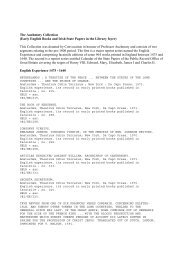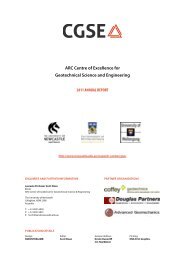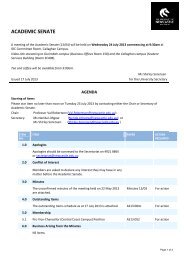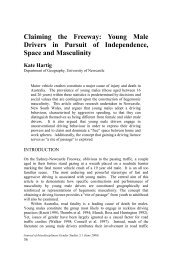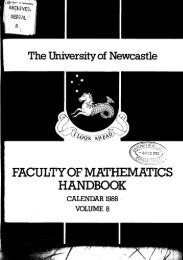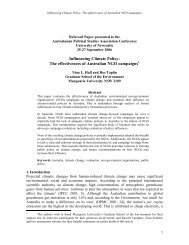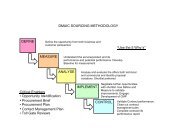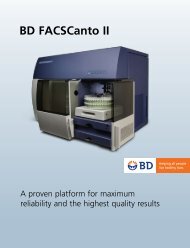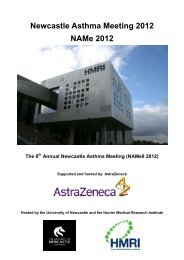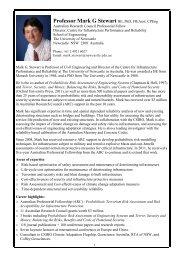Faculty of Mathematic Handbook,1987 - University of Newcastle
Faculty of Mathematic Handbook,1987 - University of Newcastle
Faculty of Mathematic Handbook,1987 - University of Newcastle
You also want an ePaper? Increase the reach of your titles
YUMPU automatically turns print PDFs into web optimized ePapers that Google loves.
Examination<br />
Content<br />
This topic will introduce basic concepts <strong>of</strong> the local theory <strong>of</strong> differentiable manifolds.<br />
Vector fields, differential forms, and their mapping. Frobenius' theorem. Fundamental<br />
properties <strong>of</strong> Lie groups and Lie algebras. General linear group. Principle and associated<br />
fibre bundles. Connections. Bundle <strong>of</strong> linear frames, affine connections. Curvature and<br />
torsion. Metric, geodesics. Riemannian manifolds.<br />
Text<br />
References<br />
Auslander, L.<br />
Chevalley, C.<br />
Kobayashi, S. & Nomizu. K.<br />
Nil<br />
664165 <strong>Mathematic</strong>al Physiology - W. Summerfield<br />
Prerequisite Nil<br />
Hours About 27 lecture hours<br />
Examination<br />
Content<br />
Differential Geometry (Harper & Row 1967)<br />
Theory <strong>of</strong> Lie Groups, Vol. I (princeton 1946)<br />
Foundations <strong>of</strong> Differential Geometry, Vol. I<br />
(Interscience 1963)<br />
One 2·hour paper<br />
Physiology " the study <strong>of</strong> how the body works based on the knowledge <strong>of</strong> how it is<br />
constructed - essentially dates from early in the seventeenth century when the English<br />
physician HalVey showed that blood circulates constantly through the body. The<br />
intrusion <strong>of</strong> engineering into this field is well know through the wide pUblicity given to<br />
(for example) heart by-pass and kidney dialysis machines. cardiac assist pace-makers. and<br />
prosthetic devices such as hip and knee joints; the obviously beneficial union has led to<br />
the establishment <strong>of</strong> Bioengineering Departments within Universities and Hospitals.<br />
Perhaps the earliest demonstration <strong>of</strong> mathematics' useful application in (some areas <strong>of</strong>)<br />
physiology is the mid-nineteenth century derivation by Hagen, from the basic equations<br />
<strong>of</strong> continuum motion, <strong>of</strong> Poiseuille's empirical formula for flow through narrow straight<br />
tubes; detailed models <strong>of</strong> the cardiovascular circulatory system have recently been<br />
developed. <strong>Mathematic</strong>al models have also been formulated for actions such as<br />
coughing, micturition and walking, as well as for the more vital processes involved in gas<br />
exchange in the lungs, mass transport between lungs and blood and blood and tissue,<br />
metabolic exchanges within tissues, enzyme kinetics, signal conduction along nelVe<br />
fibres. sperm transport in the cervix, ..... Indeed, mathematical engineering might now. be<br />
said to be part <strong>of</strong> the conspiracy to produce super humans (e.g. see "Fast Runnmg<br />
Tracks" in Dec. 1978 issue <strong>of</strong> Scientific American).<br />
This course will examine in some detail a few <strong>of</strong> the previously mentioned mathematical<br />
models; relevant physiological material will be introduced as required.<br />
Text<br />
References<br />
Bergel, D.H. (ed.)<br />
Care, C.G., Pedley, T.J.,<br />
Schroter, R.D. & Seed, W.A.<br />
Christensen, H.N.<br />
Nil<br />
Cardiovascular Fluid Dynamics (Vols I & II)<br />
(Academic 1972)<br />
The Mechanics <strong>of</strong> the Circulation (Oxford 1978)<br />
Biological Transport (W.A. Benjamin, 1975)<br />
,<br />
I<br />
Fung, Y.C<br />
Fung, Y.C<br />
Fung, Y.C, Perrone, N. &<br />
Anliker, M. (eds.)<br />
Lightfoot, E.N.<br />
Margaria, R.<br />
Pedley, T.J.<br />
West, J.B. (ed.)<br />
664105 Combinatorial Designs· (not <strong>of</strong>fered in <strong>1987</strong>)<br />
Prerequisites<br />
Hours<br />
Examinatioli<br />
Content<br />
Biodynamics: Circulation (Springer· Verlag 1984)<br />
Biomechanics: Mechanical Properties <strong>of</strong> Living<br />
Tissues (Springer-Verlag 1981)<br />
Biomechanics Its Foundations and Objectives<br />
(Prentice· Hall 1972)<br />
Transport Phelwmena and Living Systems (Wiley 1974)<br />
Biomechanics and Energetics <strong>of</strong> Muscular Exercise<br />
(Clarendon 1976)<br />
The Fluid Mechanics <strong>of</strong> Large Blood Vessels<br />
(Cambridge 1980)<br />
Bioengineering Aspects <strong>of</strong> the Lung<br />
(Marcel Dekker 1977)<br />
Topics D and K<br />
About 27 lecture hours<br />
One 2·hour paper<br />
An introduction to various types <strong>of</strong> designs and their properties. Pairwide balanced<br />
designs: the basic theory, some existence theorems, Wilson's theorems. Latin squares<br />
and balanced incomplete block designs; the existence theory using pairwise balanced<br />
designs, and various constructions. Partial balance. Room squares. Hadamard matrices.<br />
Block designs on graphs, such as handcuffed designs.<br />
Text<br />
Street, A.P. & Wallis, W.D.<br />
References<br />
Denes, J. & Keedwell, A.D.<br />
Hall, M. Jr.<br />
Mann, H.B.<br />
Raghavarao. D.<br />
Ryser, H.J.<br />
Wallis, W.D. et al.<br />
Wallis, W.D.<br />
Combinatorial Theory: An Introduction (CBRe 197)<br />
Latin Squares and their Applications<br />
(English and Akademiai Kiado 1974)<br />
Combinatorial Theory (Blaisdell 1967)<br />
Additioll Theorems. The Addition Theorems <strong>of</strong> Group<br />
Theory and Number Theory (Interscience 1965)<br />
Constructions and Combinatorial Problems in Design<br />
<strong>of</strong> Experiments (Wiley 1971)<br />
Combinatorial <strong>Mathematic</strong>s (Wiley 1963)<br />
Combinatorics: Room Squares, Sum·Free Sets,<br />
Hadamard Matrices (Springer 1972)<br />
Combinatorial Designs (Vniv. <strong>of</strong> Surrey 1977)<br />
664168 Asfrophysical Applications <strong>of</strong> Magnetohydrodynamics . W.P. Wood<br />
Prerequisites<br />
Hours<br />
Examination<br />
Content<br />
Topics CO and PD<br />
About 27 lecture hours<br />
One 2-hour paper<br />
The nonnal state <strong>of</strong> matter in the universe is that <strong>of</strong> a plasma, or ionized gas, permeated.<br />
by magnetic fields. Moreover, these fields (unlike that <strong>of</strong> the earth) may be dominant, or<br />
at least Significant, in controlling the structure <strong>of</strong> the region. The aim <strong>of</strong> this course is to<br />
investigate the effects <strong>of</strong> astrophysical magnetic fields, ranging from 10-6 gauss in the<br />
87



